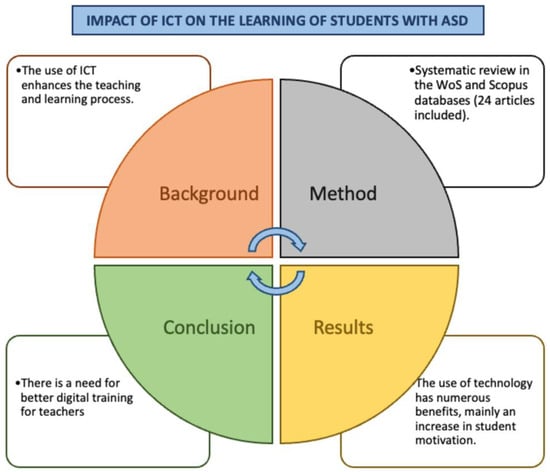Fostering Motivation: Exploring the Impact of ICTs on the Learning of Students with Autism
Abstract
1. Introduction
2. Theoretical Framework
3. Methods
3.1. Search Strategy
3.2. Inclusion and Exclusion Criteria
3.3. Methodological Quality Assessment
3.4. Data Selection and Extraction
4. Results
- Driving Themes: These are characterised by being solidly developed areas in the field, being fundamental for the organisation of the topic of study. In the thematic map, these prominent themes are located in the upper right quadrant, highlighting their importance and centrality.
- Core Themes: These are of great relevance, although they have not yet reached full development in the research field. They are placed in the lower right quadrant, indicating their potential importance and the need for further development.
- Emerging or Declining Themes: These are characterised by low density and centrality, representing areas that are emerging or experiencing a decline in research. They are located in the lower left quadrant, indicating their position in the research spectrum.
- Niche Themes: These have high density but low centrality, being highly specialised and peripheral areas in the field of study. These unique themes are found in the upper left quadrant, indicating their specialisation and relative separation from the central core of the research.
5. Discussion
6. Conclusions
6.1. Limitations
6.2. Recommendations for Practitioners and Researchers
- Prioritise Digital Skills Training:
- Overcoming Technological Barriers:
- Foster Interdisciplinary Collaborations:
Author Contributions
Funding
Institutional Review Board Statement
Informed Consent Statement
Data Availability Statement
Conflicts of Interest
References
- Gallardo Montes, C.P.; Rodríguez Fuentes, A.; Caurcel Cara, M.J. ICT training for educators of Granada for working with people with autism. Heliyon 2023, 9, e13924. [Google Scholar] [CrossRef] [PubMed]
- Arriaga, W.; Bautista, J.K.; Montenegro, L. Las TIC y su apoyo en la educación universitaria en tiempo de pandemia: Una fundamentación facto—Teórica. Rev. Conrado 2021, 17, 201–206. [Google Scholar]
- Confederación Autismo España. Autismo Calidad Vida; Confederación Autismo España—IMSERSO: Madrid, Spain, 2003. [Google Scholar]
- Tárraga Mínguez, R.; Vélez-Calvo, X.; Lacruz-Pérez, I.; Sanz-Cervera, P. Efectividad del uso de las TIC en la intervención educativa con estudiantes con TEA. Didáctica Innovación Multimed. 2019, 37, 6. [Google Scholar]
- Hernández Sánchez, B.; Sánchez García, J.C.; González Cedeño, G. Uso y presencia de las Tecnologías de las tecnologías en las personas con discapacidad intelectual y del desarrollo. Herramientas digitales en tiempos de crisis. Int. J. Dev. Educ. Psychol. 2021, 1, 135–148. [Google Scholar] [CrossRef]
- Lozano Martínez, J.; Merino Ruíz, S. Utilización de las TIC’s para desarrollar las habilidades emocionales en alumnado con TEA desde la colaboración escuela-familia-universidad: Una experiencia en un aula abierta específica. Didáctica Innovación Y Multimed. 2015, 31, 1–16. [Google Scholar]
- Virnes, M.; Kärnä, E.; Vellonen, V. Review of research on children with autism spectrum disorder and the use of technology. J. Spec. Educ. Technol. 2015, 30, 13–27. [Google Scholar] [CrossRef]
- Kumazaki, H.; Warren, Z.; Swanson, A.; Yoshikawa, Y.; Matsumoto, Y.; Yoshimura, Y.; Shimaya, J.; Ishiguro, H.; Sarkar, N.; Wade, J.; et al. Brief Report: Evaluating the Utility of Varied Technological Agents to Elicit Social Attention from Children with Autism Spectrum Disorders. J. Autism Dev. Disord. 2019, 49, 1700–1708. [Google Scholar] [CrossRef]
- Guillén, S.G.; Rojas, D.G.; Fernández, S.J. Uso de las TIC en el Trastorno de Espectro Autista: Aplicaciones. Edmetic 2016, 5, 134–157. [Google Scholar] [CrossRef][Green Version]
- Suhaila, N.A.; Nordin, N.M. Assistive Technology for Autism Spectrum Disorder: Systematic Literature Review. Int. J. Adv. Res. Educ. Soc. 2022, 4, 25–39. [Google Scholar]
- Fernández Batanero, J.M.; Montenegro Rueda, M.; Fernández Cerero, J.; García Martínez, I. Assistive technology for the inclusion of students with disabilities: A systematic review. Educ. Technol. Res. Dev. 2022, 70, 1911–1930. [Google Scholar]
- Celis Alcalá, G.; Ochoa Madrigal, M.G. Trastorno del Espectro Autista (TEA). Rev. Fac. Med. 2022, 65, 7–20. [Google Scholar] [CrossRef]
- Chauhan, S. A meta-analysis of the impact of technology on learning effectiveness of elementary students. Comput. Educ. 2017, 105, 14–30. [Google Scholar] [CrossRef]
- Sanromà-Giménez, M.; Lázaro-Cantabrana, J.L.; Gisbert-Cervera, M. La tecnología móvil: Una herramienta para la mejora de la inclusión digital de las personas con TEA. Psicol. Conoc. Soc. 2017, 7, 173–192. [Google Scholar] [CrossRef]
- Domínguez, Y. Las Emociones En El Tea: Tratamiento A Través De Las Tic. Bachelor’s Thesis, Universidad de las Palmas de Gran Canaria, Facultad de Ciencias, Las Palmas, Spain, 2019. [Google Scholar]
- Aljehany, M.S.; Bennett, K.D. Meta-analysis of video prompting to teach daily living skills to individuals with autism spectrum disorder. J. Spec. Educ. Technol. 2019, 34, 17–26. [Google Scholar] [CrossRef]
- Fernández-Batanero, J.M.; Román Graván, P.; Montenegro Rueda, M.; Fernández Cerero, J. El impacto de las TIC en el alumnado con discapacidad en la Educación Superior. Una revisión sistemática (2010–2020). EDMETIC Rev. Educ. Mediat. Tecnol. Educ. 2021, 10, 81–105. [Google Scholar]
- Cobo-Yera, C.; Belda-Torrijos, M. La mejora de las habilidades comunicativas en alumnos TEA a través de las TIC. Int. J. New Educ. 2022, 10, 5–20. [Google Scholar] [CrossRef]
- Montañez-Ruiz, J.J. Las TIC Como Contribución al Desarrollo Lectoescritor del Alumnado Con TEA. Master’s Thesis, Universidad de Jaén, Jaén, Spain, 2017. [Google Scholar]
- Cáceres, O. El Uso del Pictograma en el Proceso De Enseñanza-Aprendizaje del Niño Con Autismo; Universidad de las Palmas de Gran Canaria: Las Palmas, Spain, 2017. [Google Scholar]
- Marzal, A.; Martínez-Rico, G.; González-García, R.J.; Cañadas, M. Las TIC y la Competencia Sociocomunicativa del Alumnado con TEA: Una Revisión Sistemática. EDMETIC Rev. Educ. Mediática TIC 2023, 12, art.1. [Google Scholar] [CrossRef]
- Grynszpan, O.; Weiss, P.L.; Pérez-Diaz, F.; Gal, E. Innovative technology-based interventions for autism spectrum disorders: A meta-analysis. Autism 2014, 18, 346–361. [Google Scholar]
- Gledhill, J.; Currie, J.L. Characteristics of Teachers’ Recommended Social Support Strategies for Primary Students with ASD. Int. Online J. Prim. Educ. 2020, 9, 18–34. Available online: https://eric.ed.gov/?id=EJ1258470 (accessed on 12 December 2023).
- Romero, M.; Harari, I. Uso de nuevas tecnologías TICS-realidad aumentada para tratamiento de niños TEA un diagnóstico inicial. Rev. Divulg. Científica Univ. Tecnológica Indoamérica 2017, 6, 131–137. [Google Scholar]
- JBI. 2009. Available online: http://www.joannabriggs.edu.au/about/home.php (accessed on 10 September 2009).
- Page, M.J.; McKenzie, J.E.; Bossuyt, P.M.; Boutron, I.; Hoffmann, T.C.; Mulrow, C.D.; Shamseer, L.; Tetzlaff, J.M.; Akl, E.A.; Brennan, S.E.; et al. The PRISMA 2020 statement: An updated guideline for reporting systematic reviews. Rev. Española Cardiol. 2021, 74, 790–799. [Google Scholar] [CrossRef]
- Rose, S.; Engel, D.; Cramer, N.; Cowley, W. Automatic Key-Word Extraction from Individual Documents. In Text Mining; Berry, M.W., Kogan, J., Eds.; John Wiley & Sons Ltd.: Hoboken, NJ, USA, 2010; pp. 1–20. [Google Scholar]
- Mongeon, P.; Paul-Hus, A. The Journal Coverage of Web of Science and Scopus: A Comparative Análisis. Scientometrics 2016, 106, 213–228. [Google Scholar] [CrossRef]
- Pertegal-Vega, M.A.; Oliva-Delgado, A.; Rodríguez-Meirinhos, A. Systematic review of the current state of research on Online Social Networks: Taxonomy on experience of use. [Revisión sistemática del panorama de la investigación sobre redes sociales: Taxonomía sobre experiencias de uso. Comunicar 2019, 27, 81–91. [Google Scholar] [CrossRef]
- Aromataris, E.; Munn, Z. JBIManual for Evidence Synthesis; Joanna Briggs Institute: Adelaide, Australia, 2020. [Google Scholar]
- Aria, M.; Cuccurullo, C. Bibliometrix: An R-tool for comprehensive science mapping analysis. J. Informetr. 2017, 11, 959–975. [Google Scholar]
- Sorensen, A.; Seary, A.; Riopelle, K. Alzheimer’s Disease Research: A COIN Study Using Co-authorship Network Analytics. Procedia Soc. Behav. Sci. 2010, 4, 6582–6586. [Google Scholar] [CrossRef]
- McEwen, R. Mediating sociality: The use of iPod touch™ devices in the classrooms of students with autism in Canada. Inf. Commun. Soc. 2014, 17, 1264–1279. [Google Scholar] [CrossRef]
- Stockall, N.; Dennis, L.R. Using Pivotal Response Training and Technology to Engage Preschoolers With Autism in Conversations. Interv. Sch. Clin. 2014, 49, 195–202. [Google Scholar]
- Hochhauser, M.; Gal, E.; Weiss, P.L. Negotiation Strategy Video Modeling Training for Adolescents with Autism Spectrum Disorder: A Usability Study. Int. J. Hum. Comput. Interact. 2015, 31, 472–480. [Google Scholar]
- Parsons, S. Learning to work together: Designing a multi-user virtual reality game for social collaboration and perspective-taking for children with autism. Int. J. Child-Comput. Interact. 2015, 6, 28–38. [Google Scholar]
- Kamaruzaman, M.F.; Nor, H.M.; Azahari, M.H.H. Using touchscreen technology to support basic numeracy learning process for high functioning children with autism. Turk. Online J. Educ. Technol. 2016, 16, 632–639. [Google Scholar]
- Rani, N.M.; Ramli, S.H.; Legino, R.; Azahari, M.H.H.; Kamaruzaman, M.F. Comparative study on the engagement of students with autism towards learning through the use of mobile technology based visual schedule. Turk. Online J. Educ. Technol. 2016, 1, 132–138. [Google Scholar]
- Brodhead, M.T.; Abston, G.W.; Mates, M.; Abel, E.A. Further refinement of video-based brief multiple-stimulus without replacement preference assessments. J. Appl. Behav. Anal. 2017, 50, 170–175. [Google Scholar] [PubMed]
- Esposito, M.; Sloan, J.; Tancredi, A.; Gerardi, G.; Postiglione, P.; Fotia, F.; Napoli, E.; Mazzone, L.; Valeri, G.; Vicari, S. Using Tablet Applications for Children With Autism to Increase Their Cognitive and Social Skills. J. Spec. Educ. Technol. 2017, 32, 199–209. [Google Scholar] [CrossRef]
- Sankardas, S.A.; Rajanahally, J. iPad: Efficacy of electronic devices to help children with autism spectrum disorder to communicate in the classroom. Nasen Help. Everyone Achieve 2017, 32, 144–157. [Google Scholar] [CrossRef]
- Sahin, N.T.; Abdus-Sabur, R.; Keshav, N.U.; Liu, R.; Salisbury, J.P.; Vahabzadeh, A. Case Study of a Digital Augmented Reality Intervention for Autism in School Classrooms: Associated With Improved Social Communication, Cognition, and Motivation via Educator and Parent Assessment. Front. Educ. 2018, 3, 57. [Google Scholar]
- Eden, S.; Navon, M.; Shamir, A. Teachers’ Attitudes, Motivation, and Use of iPads to Support Children With Learning Disabilities Versus Children With Autism Spectrum Disorder. J. Cogn. Educ. Psychol. 2019, 18, 131–159. [Google Scholar] [CrossRef]
- Tuedor, M.; Franco, F.; White, A.; Smith, S.; Adams, R. Testing Literacy Educational Software to Develop Design Guidelines for Children with Autism. Int. J. Disabil. Dev. Educ. 2019, 66, 19–35. [Google Scholar] [CrossRef]
- Worthington, R. The multi-component model of harmful sexual behaviour for people with autism and co-morbid intellectual disabilities—A theory and practice guide. J. Forensic Pract. 2019, 21, 1–13. [Google Scholar]
- Wright, C.; Diener, M.; Wright, S.; Rafferty, D.; Taylor, C. Peer Teachers With Autism Teaching 3D Modeling. Int. J. Disabil. Dev. Educ. 2019, 66, 438–453. [Google Scholar] [CrossRef]
- Faria, D.R.; Bird, J.J.; Daquana, C.; Kobylarz, J.; Ayrosa, P.P.S. Towards ai-based interactive game intervention to monitor concentration levels in children with attention deficit. Int. J. Inf. Educ. Technol. 2020, 10, 641–648. [Google Scholar] [CrossRef]
- Khamparia, A.; Pandey, B.; Mishra, B.P. Effects of microworld game-based approach on neuromuscular disabled students learning performance in elementary basic science courses. Educ. Inf. Technol. 2020, 25, 3881–3896. [Google Scholar] [CrossRef]
- Mosher, M.A.; Carreon, A.C. Teaching social skills to students with autism spectrum disorder through augmented, virtual and mixed reality. Res. Learn. Technol. 2021, 29, 2626. [Google Scholar] [CrossRef]
- Laurie, M.H.; Manches, A.; Fletcher-Watson, S. The role of robotic toys in shaping play and joint engagement in autistic children: Implications for future design. Int. J. Child-Comput. Interact. 2022, 32, 100384. [Google Scholar]
- Lledó, G.L.; Lledó, A.; Gilabert-Cerdá, A.; Lorenzo-Lledó, A. The use of augmented reality to improve the development of activities of daily living in students with ASD. Educ. Inf. Technol. 2022, 27, 4865–4885. [Google Scholar] [CrossRef]
- Wu, Q.; Xu, R.; Liu, Y.; Lottridge, D.; Nanayakkara, S. Players and Performance: Opportunities for Social Interaction with Augmented Tabletop Games at Centres for Children with Autism. Proc. ACM Hum. Comput. Interact. 2022, 6, 161–184. [Google Scholar] [CrossRef]
- Gevarter, C.; Najar, A.M.; Siciliano, M. Teaching Children with Autism to Create Multi-symbol Messages on Augmentative Alternative Communication Applications During Play. Adv. Neurodev. Disord. 2023, 7, 314–328. [Google Scholar] [CrossRef]
- Mazon, C.; Clément, B.; Roy, D.; Oudeyer, P.Y.; Sauzéon, H. Pilot study of an intervention based on an intelligent tutoring system (ITS) for instructing mathematical skills of students with ASD and/or ID. Educ. Inf. Technol. 2023, 28, 9325–9354. [Google Scholar] [CrossRef]
- McGuinty, J.; Carlson, A.; Li, A.; Nelson, J.; Borges, M. Walk-in clinic counselling for emotional regulation with low-needs youth on the autism spectrum. Aust. N. Z. J. Fam. Ther. 2023, 44, 288–301. [Google Scholar] [CrossRef]
- Cobo, M.J.; Martínez, M.A.; Gutiérrez Salcedo, M.; Fujita, H.; Herrera-Viedma, E. 25 years at Knowledge-Based Systems: A bibliometric analysis. Knowl. Based Syst. 2015, 80, 3–13. [Google Scholar] [CrossRef]
- Cabanillas-Tello, A.; Cabanillas-Carbonell, M. Application Software Analysis for Children with Autism Spectrum Disorder: A Review of the Scientific Literature from 2005–2020; International Conference on e-Health and Bioengineering (EHB): Iasi, Romania, 2020; pp. 1–4. [Google Scholar] [CrossRef]
- Durán Cuartero, S. Tecnologías para la enseñanza y el aprendizaje del alumnado con Trastorno del Espectro Autista: Una revisión sistemática. Innoeduca Int. J. Technol. Educ. Innov. 2021, 7, 107–121. [Google Scholar] [CrossRef]
- Centers of Disease Control and Prevention. Prevalence of Autism spectrum Disorder among Children Aged 8 years. Autism and developmental Disability Monitory network, 11 Sites, United Stated. MMWR Surveill. Summ. 2018, 69, 1. [Google Scholar]
- Kagohara, D.M.; van der Meer, L.; Ramdoss, S.; O’Reilly, M.F.; Lancioni, G.E.; Davis, T.N.; Rispoli, M.; Lang, R.; Marschik, P.B.; Sutherland, D.; et al. Using iPods® and iPads® in teaching programs for individuals with developmental disabilities: A systematic review. Res. Dev. Disabil. 2013, 34, 147–156. [Google Scholar] [CrossRef]
- Martín, A.; Hervás, R.; Méndez, G.; Bautista, S. PICTAR: Una Herramienta de Elaboración de Contenido Para Personas Con TEA Basada en la Traducción de Texto a Pictogramas. In Proceedings of the XIX International Conference on Human-Computer Interaction (Interacción 2018), Palma de Mallorca, Spain, 12–14 September 2018. [Google Scholar]
- Pérez-Fúster, P.; Sevilla, J.; Herrera, G. Enhancing daily living skills in four adults with autism spectrum disorder through an embodied digital technology-mediated intervention. Res. Autism Spectr. Disord. 2019, 58, 54–67. [Google Scholar] [CrossRef]
- Pellicano, E.; Dinsmore, A.; Charman, T. What should autism research focus upon? Community views and priorities from the United Kingdom. Autism 2014, 18, 756–770. [Google Scholar] [CrossRef] [PubMed]
- López Belmonte, J.; Moreno Guerrero, A.J.; Marín Marín, J.A.; Lampropoulos, G. El impacto del género en el uso de la realidad aumentada y la realidad virtual en estudiantes con TEA. Educ. Knowl. Soc. 2022, 23, 1–14. [Google Scholar]
- Lainez, B.; Chocarro de Luis, E.; Busto, J.H.; López, J. Aportaciones de la Realidad Aumentada en la inclusión en el aula de estudiantes con Trastorno del Espectro Autista. Rev. Educ. Mediática TIC 2018, 7, 120–134. [Google Scholar] [CrossRef]
- Fernández Rueda, I. Robótica Educativa Adaptada al Alumnado Con TEA; Universidad de Sevilla: Seville, Spain, 2020. [Google Scholar]
- Montenegro-Rueda, M.; Fernández-Batanero, J.M. Adaptation and validation of an instrument for assessing the digital competence of special education teachers. Eur. J. Spec. Needs Educ. 2023. [Google Scholar] [CrossRef]
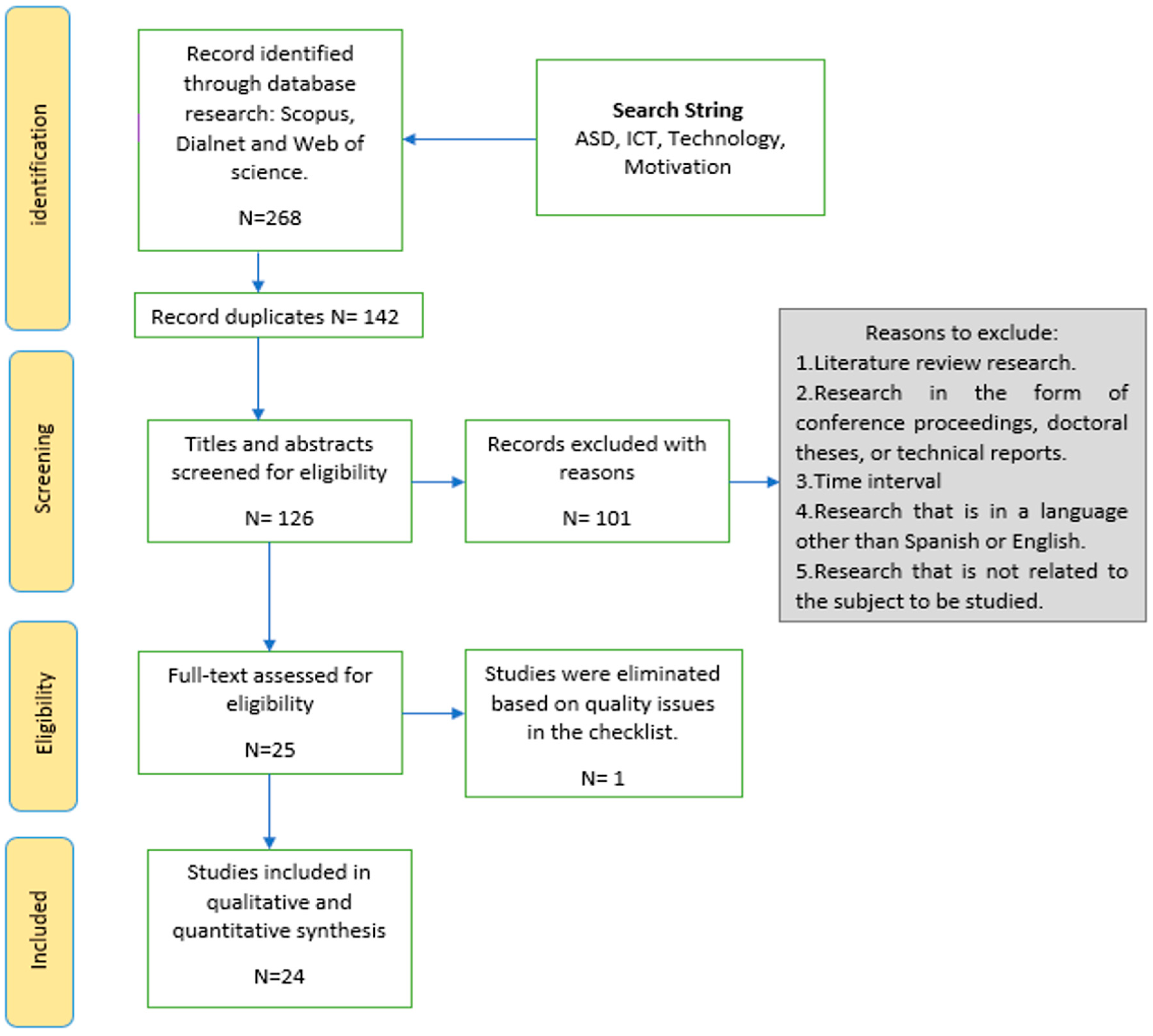
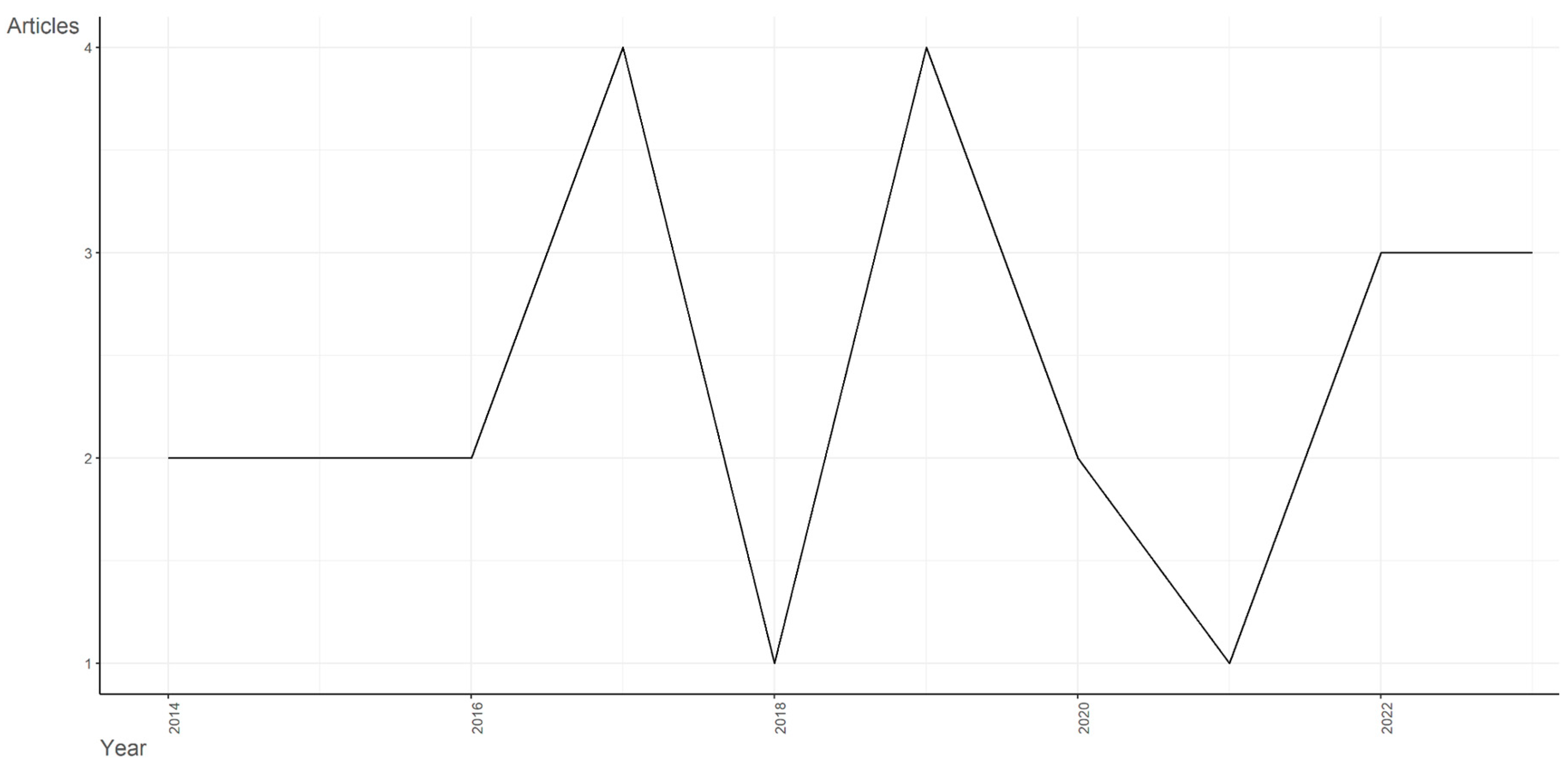
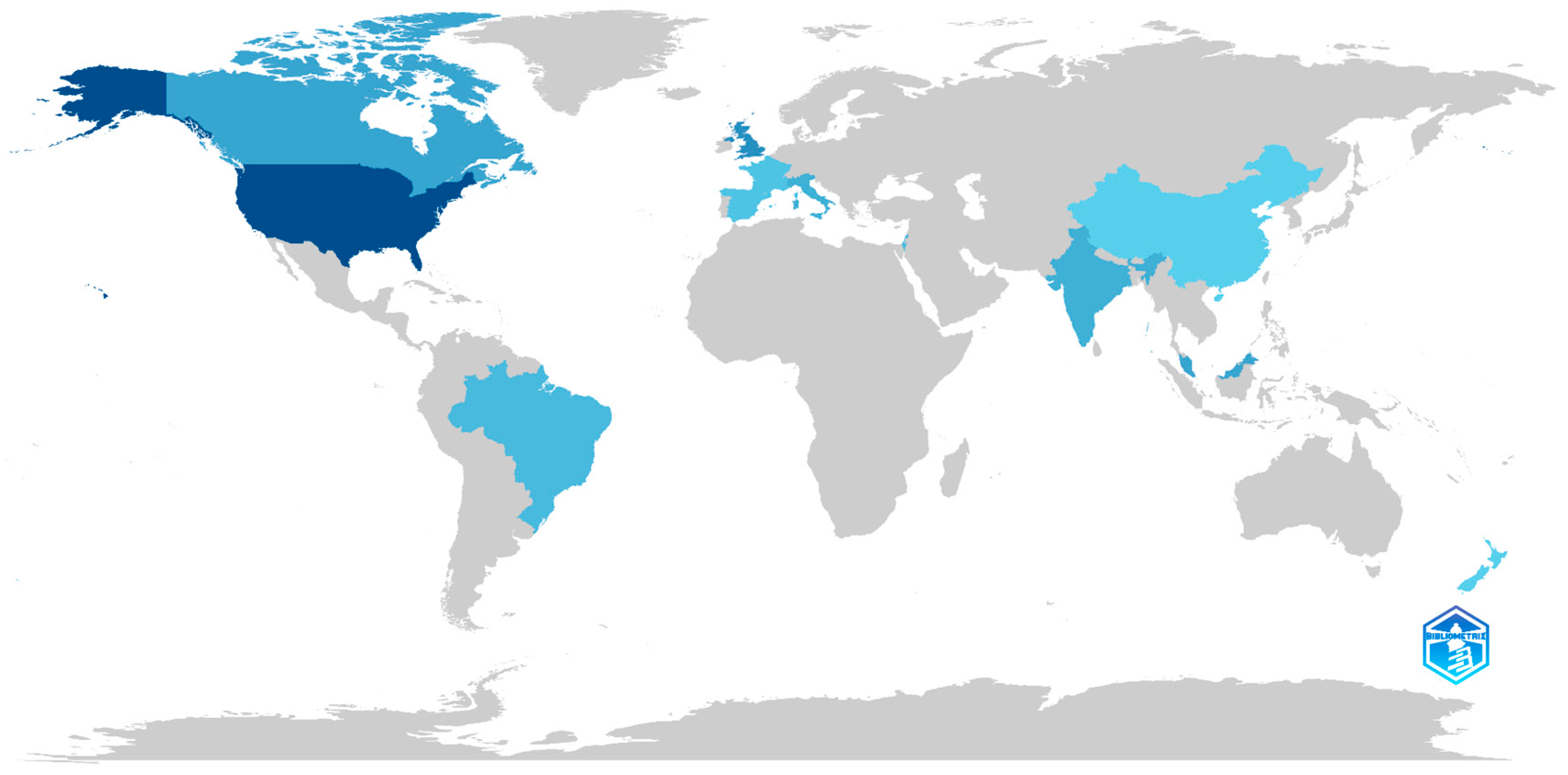
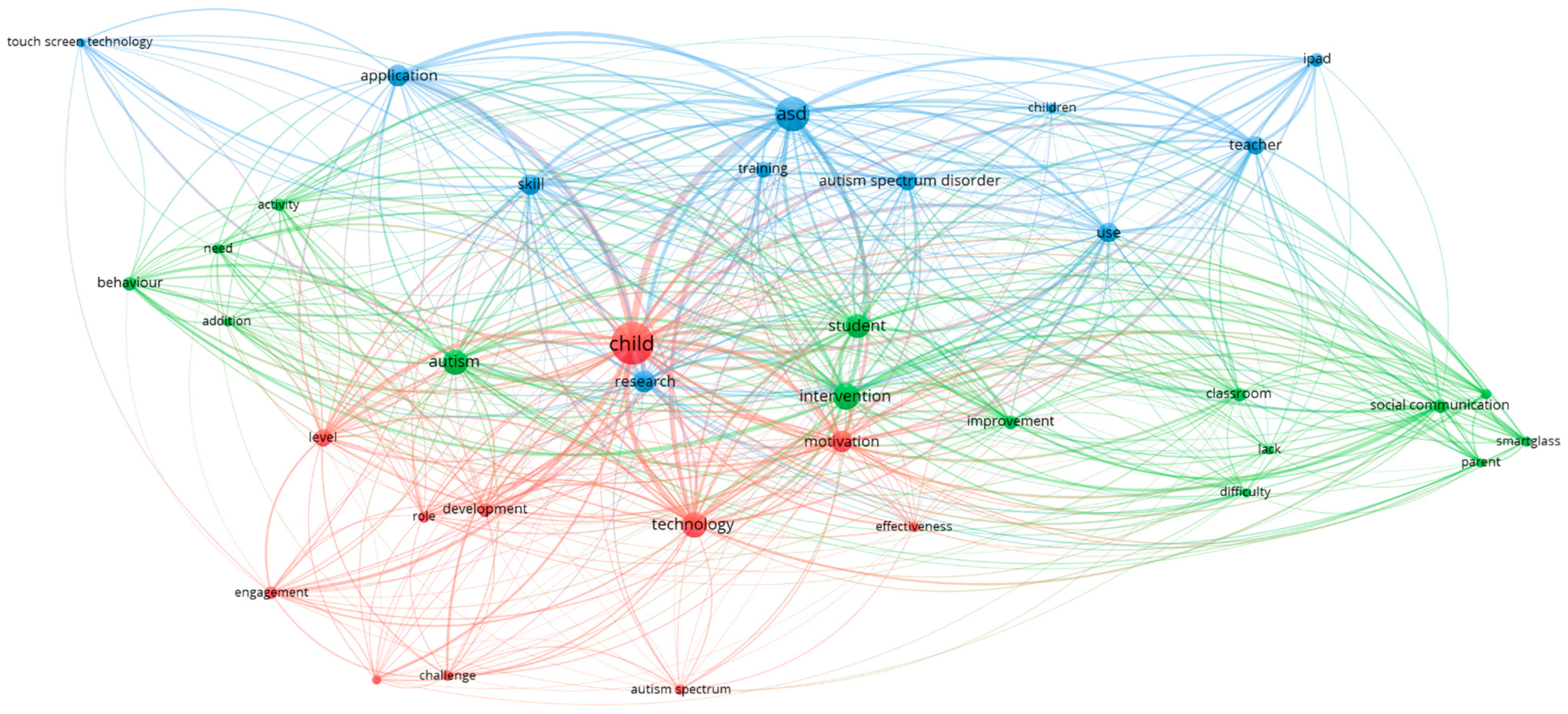
| Nº | Search Strategy |
|---|---|
| #1 | (“ASD” AND “ICT” AND “Motivation”) OR (“TEA” AND “TIC” AND “Motivación”) |
| #2 | (“ASD” AND “Technology” AND “Motivation”) OR (“TEA” AND “Tecnología” AND “Motivación”) |
| #3 | (“Autism” AND “ICT” AND “Motivation”) OR (“Autismo” AND “TIC” AND “Motivación”) |
| #3 | (“Autism” AND “Technology” AND “Motivation”) OR (“Autismo” AND “Tecnología” AND “Motivación”) |
| PICoS Strategy | Inclusion Criteria | Exclusion Criteria |
|---|---|---|
| Population | Indexed in Web of Science, Dialnet or Scopus | Publication not indexed in these three databases |
| Scientific article published in a peer-reviewed journal | Not an article published in a scientific journal | |
| Published between 2014 and 2023 | Published before 2014 | |
| Articles published in English or Spanish | Article published in a language other than English or Spanish | |
| Phenomenon of interest | Analyses the impact of ICTs on the motivation of learners with ASD | Does not analyse the impact of ICTs on the motivation of students with ASD |
| Context | Focuses on the field of education | Does not focus on the field of education |
| Study design | Empirical research | Not empirical research |
| Checklist | Yes (1 Point) | No (0 Point) |
|---|---|---|
| Is the aim of the research clearly specified? | ✓ | X |
| Is the participant sample students with ASD? | ✓ | X |
| Are the instruments used for data collection appropriate? | ✓ | X |
| Are the results obtained useful for the scientific community? | ✓ | X |
| Are the authors’ conclusions based on the data analysed? | ✓ | X |
| Are recommendations made for future research? | ✓ | X |
| Are the limitations of the research included? | ✓ | X |
| Author | Year | Methodology | Results |
|---|---|---|---|
| McEwen [33] | 2014 | Quantitative | The use of tactile technologies (iPod) favours communication, motivation, attention of students with ASD |
| Stockall and Dennis [34] | 2014 | Qualitative | The use of technology promotes motivation and empowerment of students with ASD. |
| Hochhauser et al. [35] | 2015 | Qualitative | The application of video modelling supports the competence and intrinsic motivation of students with ASD. |
| Parsons [36] | 2015 | Quantitative | A virtual reality game can improve the skills and motivation of these students. |
| Kamaruzaman et al. [37] | 2016 | Qualitative | Touchscreen technology enhances learning for students with ASD |
| Rani et al. [38] | 2016 | Qualitative | Mobile technology is beneficial for motivation and participation of students with ASD |
| Brodhead et al. [39] | 2017 | Qualitative | Video-based technology provides benefits for students with ASD |
| Espósito et al. [40] | 2017 | Qualitative | The use of tablet applications increases the cognitive and social skills of students with autism. |
| Sankardas and Rajanahally [41] | 2017 | Qualitative | The use of electronic devices (iPad) in the classroom promotes motivation and communication of students with ASD. |
| Sahin et al. [42] | 2018 | Quantitative | Assistive technologies show improvement in communication and motivation of students with ASD |
| Eden et al. [43] | 2019 | Quantitative | The iPad is a useful tool to promote the teaching of students with ASD, but training is lacking. |
| Tuedor et al. [44] | 2019 | Quantitative | Reading support software supports the participation and motivation of students with ASD. |
| Worthington [45] | 2019 | Quantitative | Technologies favour students with autism |
| Wright et al. [46] | 2019 | Quantitative | Three-dimensional technology favours learning and motivation of students with autism, but there is a lack of training. |
| Faria et al. [47] | 2020 | Quantitative | AI-based interactive games promote concentration and motivation. |
| Khamparia et al. [48] | 2020 | Qualitative | The use of interactive learning environments enhances the learning process and motivation of students. |
| Mosher and Carreon [49] | 2021 | Qualitative | The use of augmented reality has potential to improve the social skills and motivation of students with ASD. |
| Laurie et al. [50] | 2022 | Qualitative | Robotic toys create different opportunities for autistic learners |
| Lledó et al. [51] | 2022 | Quantitative | The use of augmented reality has the potential to enhance the development of activities and motivation of students with ASD. |
| Wu et al. [52] | 2022 | Qualitative | Augmented reality favours social interaction and motivation of children with ASD |
| Gevarter et al. [53] | 2023 | Qualitative | The use of augmentative alternative communication through games favours the development of skills. |
| Mazon et al. [54] | 2023 | Qualitative | Intelligent tutoring improves mathematical skills and motivation of students with ASD |
| McGuinty et al. [55] | 2023 | Qualitative | Virtual and interactive technology promotes emotional regulation of students with ASD |
Disclaimer/Publisher’s Note: The statements, opinions and data contained in all publications are solely those of the individual author(s) and contributor(s) and not of MDPI and/or the editor(s). MDPI and/or the editor(s) disclaim responsibility for any injury to people or property resulting from any ideas, methods, instructions or products referred to in the content. |
© 2024 by the authors. Licensee MDPI, Basel, Switzerland. This article is an open access article distributed under the terms and conditions of the Creative Commons Attribution (CC BY) license (https://creativecommons.org/licenses/by/4.0/).
Share and Cite
Fernández-Batanero, J.M.; Montenegro-Rueda, M.; Fernández-Cerero, J.; López-Meneses, E. Fostering Motivation: Exploring the Impact of ICTs on the Learning of Students with Autism. Children 2024, 11, 119. https://doi.org/10.3390/children11010119
Fernández-Batanero JM, Montenegro-Rueda M, Fernández-Cerero J, López-Meneses E. Fostering Motivation: Exploring the Impact of ICTs on the Learning of Students with Autism. Children. 2024; 11(1):119. https://doi.org/10.3390/children11010119
Chicago/Turabian StyleFernández-Batanero, José María, Marta Montenegro-Rueda, José Fernández-Cerero, and Eloy López-Meneses. 2024. "Fostering Motivation: Exploring the Impact of ICTs on the Learning of Students with Autism" Children 11, no. 1: 119. https://doi.org/10.3390/children11010119
APA StyleFernández-Batanero, J. M., Montenegro-Rueda, M., Fernández-Cerero, J., & López-Meneses, E. (2024). Fostering Motivation: Exploring the Impact of ICTs on the Learning of Students with Autism. Children, 11(1), 119. https://doi.org/10.3390/children11010119






